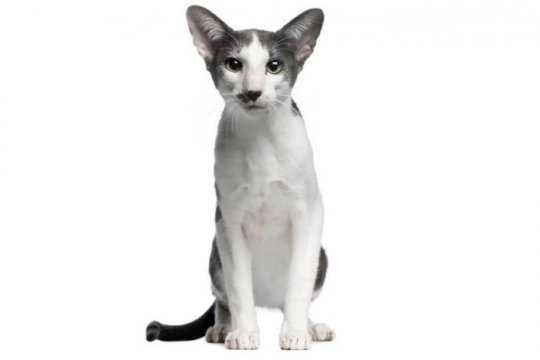Oriental Bicolor

Origin
United States
Height
8"- 10"
Adult Weight
8 - 12 pounds
Life Span
8-12 years
TEMPERAMENT
Affectionate, inquisitive, gregarious, athletic
OTHER NAMES
Foreign type, Oriental Bicolour
Group
Medium-sized Short-haired
Price
$400-$2000
Personality and Temperament
Care
- NUTRITION
- GROOMING
- EXERCISE
- HEALTH
Characteristics
History
The Breed Standard
Body
The body is long, slim, and tubular. Oriental Bicolour cats should appear lithe and athletic.
Head
The head is triangular, with a wedge-shaped muzzle and a long, straight nose that creates a distinctive elongated profile.
Eyes
The eyes should be medium size, with an almond shape. They should slant slightly, continuing the visual lines that the head and ears create. Various eye colors are accepted; most Oriental Bicolor cats have green eyes; colorpoint varieties typically have blue eyes.
Ears
The Oriental Bicolour cat should have very large ears that continue the triangular lines of the head. The ears should have wide bases and pointed tips.
Legs & Paws
The legs should be long and slim, with the hind legs being longer than the forelegs. Paws should be small and dainty, and should exhibit an oval shape.
Tail
The tail should be long and thin, and should taper to a fine point.
Coat
The coat may be long or short, with a soft, silky texture. Most Oriental Bicolour cats have short coats.
Color
Color requirements depend on registry. In most cases, the term “Oriental Bicolor” refers to solid color Oriental cats with white spots in their coats.
Frequently Asked Questions
-
How much does a Oriental Bicolor cat cost?
How much does a Oriental Bicolor cat cost?Oriental Bicolor cats cost between $400-$2000. -
How big do Oriental Bicolor cats get?
How big do Oriental Bicolor cats get?Oriental Bicolor cats tend to be medium in size. A fully grown Oriental Bicolor cat might weigh between 8 - 12 pounds or more and range in height anywhere from about 8"- 10" inches tall. -
How long do Oriental Bicolor cats live?
How long do Oriental Bicolor cats live?The Average lifespan for Oriental Bicolor is 8-12 years. -
Do Oriental Bicolor cats shed?
Do Oriental Bicolor cats shed?Oriental Bicolor are short-haired cats. Therefore, they do not shed as much as long-haired cat breeds.